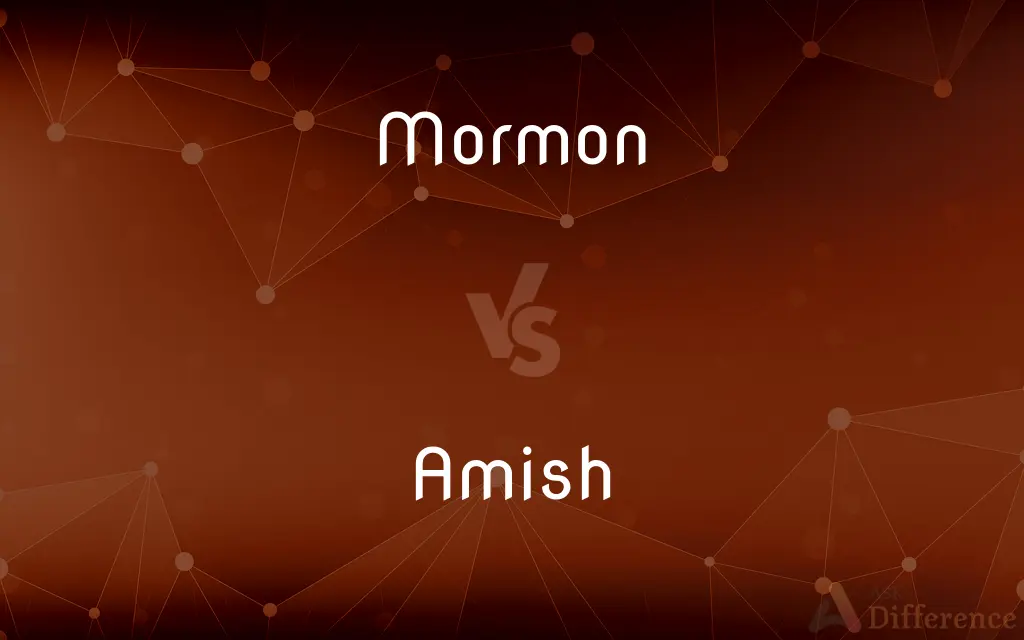Mormon vs. Amish — What's the Difference?
By Fiza Rafique & Urooj Arif — Updated on March 13, 2024
Mormonism is a Christian restorationist religion with modern revelations and a global church structure, while Amish Christianity emphasizes simple living, plain dress, and separation from the modern world.

Difference Between Mormon and Amish
Table of Contents
ADVERTISEMENT
Key Differences
Mormonism, formally known as the Church of Jesus Christ of Latter-day Saints (LDS), believes in the Bible and other scriptures like the Book of Mormon. It emphasizes modern revelations, a living prophet, and global missionary work. The Amish, originating from the Anabaptist movement in the 16th century, focus on community life, simplicity, and a strict separation from modern technologies and conveniences.
While Mormons participate actively in modern society and use technology, the Amish live in a way that avoids most modern technology to maintain simplicity, community, and religious purity. This includes travel by horse and buggy, no electricity from public grids, and traditional farming methods.
Mormon services include a variety of modern conveniences and are held in chapels and temples around the world, reflecting their global presence and emphasis on proselytizing. In contrast, Amish religious services are held in homes or community buildings without electronic amplification or modern conveniences, emphasizing community and simplicity.
The LDS Church has a hierarchical structure with a president-prophet at the top and a complex organization of bishops, stakes, and general authorities. The Amish church is organized into local, autonomous congregations without a central governing body, reflecting their emphasis on community decisions and simplicity.
Mormons believe in a pre-mortal existence and a three-tiered heaven, with practices aimed at achieving the highest level of celestial glory. The Amish focus on living a life in accordance with Jesus' teachings, with an emphasis on humility, simplicity, and the hope of heaven, but without a detailed theology of the afterlife.
ADVERTISEMENT
Comparison Chart
Foundation
Founded in the early 19th century by Joseph Smith.
Originated from the Anabaptist movement in the 16th century.
Scriptures
Bible, Book of Mormon, Doctrine and Covenants, Pearl of Great Price.
Bible.
Modern Technology
Utilizes modern technology for proselytizing and daily life.
Avoids most modern technology to maintain simplicity and religious purity.
Worship Services
Held in modern chapels and temples with a global presence.
Held in homes or community buildings, without modern conveniences.
Organizational Structure
Hierarchical with a president-prophet, bishops, and general authorities.
Local, autonomous congregations without a central governing body.
Beliefs on Afterlife
Belief in a pre-mortal life and a three-tiered heaven.
Emphasis on living according to Jesus' teachings, with a hope of heaven but without detailed afterlife theology.
Lifestyle
Active participation in modern society.
Simple living, plain dress, separation from the modern world.
Compare with Definitions
Mormon
A restorationist Christian faith with additional scriptures.
Mormons follow teachings from the Bible and the Book of Mormon.
Amish
Christian group emphasizing simplicity and community.
Amish communities prioritize a simple life, closely following Jesus' teachings.
Mormon
Global missionary work is central.
Mormon missionaries can be found in many countries, sharing their faith.
Amish
Religious services in homes or community buildings.
Amish hold their worship services in homes, without electricity or modern gadgets.
Mormon
Believes in a detailed plan of salvation.
Mormonism teaches about a pre-mortal existence and a three-tiered heaven.
Amish
Avoids most modern technology.
The Amish use horse and buggy instead of cars, avoiding modern technology.
Mormon
Uses modern technology in worship and daily life.
Mormons use websites and apps to spread their message.
Amish
Autonomous local congregations.
Amish congregations make decisions locally without a central governing body.
Mormon
Of or pertaining to or characteristic of the Mormon church;
Mormon leaders
The former Mormon practice of polygamy
Amish
Lifestyle focused on humility and separation from the world.
The Amish lifestyle is marked by plain dress and separation from the modern world.
Mormon
Hierarchical church structure.
The LDS Church is led by a president-prophet and has a complex organizational hierarchy.
Amish
The Amish (; Pennsylvania German: Amisch; German: Amische) are a group of traditionalist Christian church fellowships with Swiss German and Alsatian Anabaptist origins. They are closely related to Mennonite churches.
Mormon
An ancient prophet believed to have compiled a sacred history of the Americas, which was translated and published by Joseph Smith as the Book of Mormon in 1830.
Amish
An orthodox Anabaptist sect that separated from the Mennonites in the late 17th century and exists today primarily in Ohio, Pennsylvania, and Indiana.
Mormon
A member of the Mormon Church. Also called Latter-day Saint.
Amish
Of or relating to this sect or its members.
Mormon
Of or relating to the Mormons, their religion, or the Mormon Church.
Amish
The Amish Mennonites.
Mormon
Any of various dark-coloured Asian species of papilionid butterflies of the genus Papilio.
Amish
Of, pertaining to, or designating, the followers of Jacob Amman, a strict Mennonite of the 17th century, who even proscribed the use of buttons and shaving as "worldly conformity". There are several branches of Amish Mennonites in the United States. A branch having particularly strict adherence to the Amish principles are called Old Order Amish
Mormon
A genus of sea birds, having a large, thick bill; the puffin.
Amish
An American follower of the Mennonite religion
Mormon
One of a Christian denomination (The Church of Jesus Christ of Latter-day Saints) in the United States, followers of Joseph Smith, who professed to have found an addition to the Bible, engraved on golden plates, called the Book of Mormon, first published in 1830. The Mormons believe in polygamy, and their hierarchy of apostles, etc., has control of civil and religious matters.
Mormon
A member of a sect, called the Reorganized Church of Jesus of Latterday Saints, which has always rejected polygamy. It was organized in 1852, and is represented in about forty States and Territories of the United States.
Mormon
Of or pertaining to the Mormons; as, the Mormon religion; Mormon practices.
Mormon
The ancient prophet whose writings were revealed to Joseph Smith who founded the Mormon Church
Mormon
A member of the Mormon Church
Common Curiosities
What are the core beliefs of the Amish?
The Amish believe in simplicity, community, and separation from the modern world, focusing on living according to the teachings of Jesus Christ without modern technologies.
What is Mormonism?
Mormonism, or the LDS Church, is a Christian restorationist religion that includes the Bible and additional scriptures like the Book of Mormon in its teachings, with a global presence and a hierarchical organizational structure.
What is the organizational structure of the Mormon Church?
The Mormon Church has a hierarchical structure with a president-prophet, bishops, and general authorities overseeing its global congregation.
How do Mormon and Amish views on technology differ?
Mormons utilize modern technology for daily life and evangelism, while the Amish avoid most modern technologies to maintain their simple lifestyle.
Can Amish use any modern technologies?
The Amish may use certain technologies if they do not disrupt their simple lifestyle and community values, but they generally avoid most modern conveniences.
Do Mormons and Amish share any common beliefs?
Both Mormons and Amish are Christian groups that emphasize living a life based on religious principles, though their doctrines and practices significantly differ.
How do Mormon missionary efforts compare to Amish evangelism?
Mormon missionary efforts are organized, global campaigns, whereas Amish evangelism is more personal and based within their own communities.
How do Amish communities govern themselves?
Amish communities are governed by local congregations through community consensus, without a central authority.
What is the Amish stance on education?
The Amish value education but typically run their own schools through the eighth grade, emphasizing practical skills over higher education.
What role does the Book of Mormon play in Mormonism?
The Book of Mormon is considered another testament of Jesus Christ, complementing the Bible in Mormon doctrine.
How does the Amish lifestyle reflect their religious beliefs?
The Amish lifestyle of simplicity, plain dress, and separation from modern society is a direct reflection of their commitment to humility and religious purity.
What is shunning in the Amish community?
Shunning, or Meidung, is a practice of social exclusion used by the Amish to enforce community norms and religious adherence.
How do Mormons view the afterlife?
Mormons believe in a detailed plan of salvation that includes a pre-mortal existence, mortal life, and a three-tiered heaven based on one's life and choices.
Share Your Discovery

Previous Comparison
Passage vs. Passageway
Next Comparison
Milk vs. MilkyAuthor Spotlight
Written by
Fiza RafiqueFiza Rafique is a skilled content writer at AskDifference.com, where she meticulously refines and enhances written pieces. Drawing from her vast editorial expertise, Fiza ensures clarity, accuracy, and precision in every article. Passionate about language, she continually seeks to elevate the quality of content for readers worldwide.
Co-written by
Urooj ArifUrooj is a skilled content writer at Ask Difference, known for her exceptional ability to simplify complex topics into engaging and informative content. With a passion for research and a flair for clear, concise writing, she consistently delivers articles that resonate with our diverse audience.














































